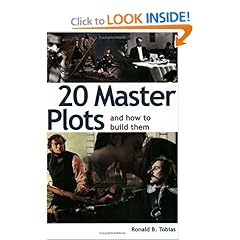20 Master Plots

I was having some issues with the direction my protagonist was taking. Somehow, I came up with how to end the story but I wasn't sure how I would get there. So I picked up 20 Master Plots: And How to Build Them by Ronald Tobias from my favorite library, Lillian Smith.
Before I continue, I must admit the book is quite detailed in its examples and I recommend few hours of reading before you judge the worth of this book yourself.
At a glance, it's a fairly easy reading. Don't be fooled. Once I started comparing the plot patterns, I realize it's not as easy as it seems. More on this later.
Ronald divides plots into two arch-types: Body(Action) and Mind. Then from there, he further divides tried-and-true plot lines into twenty odd concepts.
- Quest
- Adventure
- Pursuit
- Rescue
- Escape
- Revenge
- The Riddle
- Rivalry
- Underdog
- Temptation
- Metamorphosis
- Transformation
- Maturation
- Love
- Forbidden Love
- Sacrifice
- Discovery
- Wretched Excess
- Ascension
- Descension
For example, quest, he states, is a plot of mind since the protagonist must change at the end of the story. Adventure, on the other hand, is of the action, despite its similarity to the Quest. The main character may be too busy surviving the adventure that there may not be enough time for self-growth.
I am definitely interested in Adventure, Underdog and Sacrifice themes. But these are for future stories.
At first, I thought Gift of Harea followed #17. Discovery, according to Ronald, "is about people and their quest to understand who they are." The emphasis is on the effect. Another aspect of this concept is that the crisis should happen early, and make sure the character's revelation matches the event.
Currently, the focal character in the story goes through some fantastical events. And I don't think they quite match the revelation. And it also doesn't bring in the crisis, the big one anyway, until half way through.
So I thought perhaps this is more of a maturation story. #13 above. Ronald, in the book, distinguish Maturation from Discovery by saying Maturation starts with innocence and ends with adulthood.
In a way, this fits the character profile...except the resolution is not simply about her becoming an adult. Perhaps it is but I also didn't want to start off with a naive child like character. Hmm...she is in a way but I'd like think it's by choice, not by innocence.
So I flipped some more and thought perhaps plot #12 might fit it better. I actually skimmed through Transformation because I really thought Discovery would be more of a plot I'd like to follow. See, Transformation is more akin to Metamorphosis but sans physical change...and more internal growth.
To recap:
If you start with a child and ends up with an adult, you have a Maturation.
If you start with an adult and focus on the process, you have Transformation.
If you start with an adult and focus on the effect, you have Discovery.
If you start with either and stays in the same stage but in a different physical form, you have Metamorphosis.
In the ends, these are just guide lines to be learned and broken. I am reading these to better understand why I feel uncomfortable with the story's current state of change. I think issue is that I haven't quiet decided what it's about.
I went back to the theme I started, which no longer dovetailed, and somehow realize the parallel theme of self-respect/self-esteem.
More thinking or too much thinking? Perhaps I should hit the story and finish it first.
I am still on the fence about this book....but it made me think so it's all good, in my book.